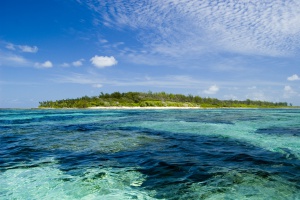Lima climate conference needed to have real outcome to make a difference, says Seychelles climate ambassador
Climate |Author: Sharon Meriton-Jean | December 17, 2014, Wednesday @ 10:13| 4156 views
Low-lying islands of the Seychelles could face disastrous effects if carbon emission targets to curtail climate change are not met in UN conference to be held in Paris next year.(Gerard Larose, Seychelles Tourism Board)
(Seychelles News Agency) - After bitter disputes and major compromises, the much talked-about climate conference in in Lima, Peru, ended on Sunday, and the Seychelles islands delegation left South America with concerns that the agreement reached in Lima is ‘ not on track’ for a targeted reductions in global temperature rises.
The delegates had intended to use the conference of the United Nations Framework Convention on Climate Change as a platform to define the individual country plans targeting the reduction of greenhouse gas emissions for nearly 200 countries. This is in preparation for a final agreement on emissions which is planned at the Paris climate conference in December 2015, and which would take effect in 2020.
In a press statement from the Ministry of Foreign Affairs, Seychelles Ambassador for SIDS and climate change issues, Ronny Jumeau said Lima was not a ‘short stop’ on the way to a final agreement in Paris.
’We needed to have real outcomes to be able to make a difference’, says Jumeau. Adding that the world must be concerned ‘as we are as yet not on track in relation to our current ambition in relation to reducing global temperature rises’.
At the end of the 20th meeting of the Conference of Parties (COP) however, much to the chagrin of environmentalist and climate change activists, the negotiators committed only to submit their carbon emission plans by March 2015.
Furthermore the Lima agreement has few obligations for countries to provide details about their emission reduction pledges and does not provide mechanisms for comparison of pledges between countries.
The UN text says the country emission plans or “Intended Nationally Determined Contributions, “may include…quantifiable information on the reference point (including, as appropriate, a base year), time frames and/or periods for implementation, scope and coverage, planning processes, assumptions and methodological approaches including those for estimating and accounting for anthropogenic greenhouse gas emissions.” The term ‘may include’ substituted the stronger terminology of ‘shall provide,’ of a previous draft, according to The Guardian.
Seychelles to continue to push for fair deal in Paris
The Seychelles, an archipelago of 115 islands in the west of the Indian Ocean with a 90,000 population, had called for the draft climate agreement to limit the global temperature rise below 1.5 degrees Celsius, together with member countries of the Alliance of Small Island States (AOSIS).
|
|
| Head of the Seychelles delegation, Jean-Paul Adam addressing delegates at the 20th meeting of the Conference of Parties (COP) of the UN conference of the United Nations Framework Convention on Climate Change, in Lima, Peru. (Ministry of Foreign Affairs) Photo License: CC-BY |
In the foreign affairs ministry press statement, the Minister of Foreign Affairs, Jean-Paul Adam, asserted that such negotiations can be ‘complex’ but that more was at stake at Lima.
‘…this is not just about a text that will bind nations’, says Adam. ‘It is about the health of our planet and the future we wish to bequeath on our children’.
In spite of a lack of a binding document, Adam says the conference has shown that small island states must have more ambition.
‘We must underline that the window for action is short and that our current targets are inadequate’, he says in the statement, which also highlights a series of discussions that the Seychelles delegation held whilst in Peru to further emphasize the Indian Ocean islands climate change concerns.
One positive outcome in Lima, was the news that the Green Climate Fund had received substantial donations from developed countries which are aimed at helping developing nations to adapt to climate change and cut their greenhouse gas emissions.
The Fund surpassed a UN goal of $10 billion, with donations helped by Australia and Belgium, and plans were announced for developed nations to mobilise $100bn a year, for developing nations by 2020.
“Seychelles delegation welcomed news in Lima that the Green climate Fund (GCF) has been capitalized beyond its initial target of 10 billion USD, but highlighted the need to maintain momentum in this push to mobilize resources as the long term capitalization of the fund remains a concern,” reads the Seychelles delegation’s press statement.
As the clock starts ticking towards the next climate talks in Paris and a possible agreement for the reversal of the climate change effects on the world, the Seychelles minister says the ‘concerns of the most vulnerable be given more prominence..’.
“We reiterate our call for mechanisms that protect the most vulnerable- SIDS [small island developing states] and LDCs [least developed countries]. It is in fact by protecting the most vulnerable that we will also provide protection for everyone.”
Back

